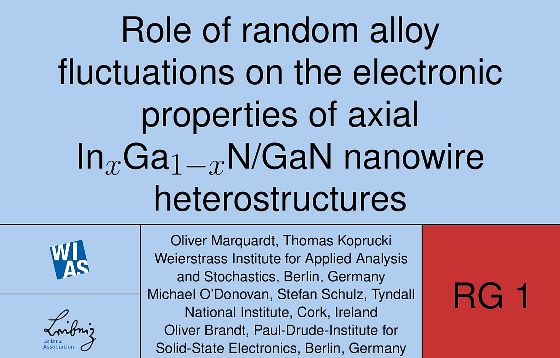Nanostructures9 Videos



N02 – Influence of random alloy fluctuations on the electronic properties of axial In(x)Ga(1−x)N/GaN nanowire heterostructures
Compound semiconductor heterostructures such as quantum dots, nanowires, or thin films, are commonly subject to randomly fluctuating alloy compositions if they contain ternary and quaternary alloys. These effects are obviously of an atomistic nature and thus rarely considered in heterostructure designs that require simulations on a continuum level for theory-guided design or interpretation of observations. […]
N03 – Band structures in highly strained 3D nanowires
We mathematically derive a new nonlinear strain model to simulate the conduction and valence bands in highly bent 3D hexagonal nanowires with GaAs core and asymmetric (AlαIn1-α)As stressor. The model is based on a transformation of the 1st Piola-Kirchhoff stress tensor and an appropriate energy functional that captures the dynamics of the induced strain due […]
N04 – An Efficient Workflow of Modeling Single-Nanowire Based Single-Photon Avalanche Detectors
Single-photon detector (SPD) as an essential building block for detecting and counting photons, plays a fundamental role in quantum technologies. In this work, we propose an efficient workflow of modeling SPDs based on emerging one-dimensional materials, i.e. nanowires, utilizing avalanche breakdown in reverse biased condition. Comparing to another extensively studied platform, superconducting nanowire SPDs, avalanche […]
N05 – Effect of Poole-Frenkel emission on electroluminescence in quantum dot light emitting devices with Nickel Oxide layer
Theoretical analysis of hybrid quantum dot-light emitting devices incorporating CdSe/ZnS core/shell quantum dots and Nickel Oxide (NiO) as hole injection layer (HIL) has been carried out in this work. The replacement of organic HIL such as poly(3,4-ethylenedioxythiophene):poly(styrenesulfonate) (PEDOT:PSS) with solution-processed NiO layer has led to enhancement of current density and luminance in the device by […]
N06 – Numerical simulations of nonparaxial solitons and their interaction dynamics in coupled Helmholtz systems
The role of nonparaxiality provides a fertile ground for fabricating miniaturized nanoscale devices. In this work, we examine the existence of nonparaxial solitons in a dimensionless coupled nonlinear Helmholtz system, allowing the propagation of ultra-broad nonparaxial pulses in a birefringent optical waveguide. We analytically obtain a bright soltion solution by using standard Hirota’s bilinearization method. […]
N07 – DFT investigation of optoelectronic properties of ultra-small C, CN and SiC nanotubes
We investigated the optoelectronic properties of ultra-small armchair (3,3) carbon (C), carbon nitride (CN) and silicon cabride (SiC) nanotubes using the density functional theory (DFT). We performed the calculations for two potentials Perdew-Burke-Ernzerhof Generalized Gradient Approximation (PBEGGA) and Tran-Blaha modified Becke-Johnson (TB-mBJ) potential. The results show a semiconducting nature with direct and indirect gap for […]
N08 – Inverse Design of Multilayer Thin film by Deep Neural Network
Inverse Design of TiO2 − SiO2 based multilayer thin film for normal incidence of TM polarized light in visible region by Deep Neural Network is reported. The simulated and the target transmission spectra are closely following.
N09 – Beam shaping using a chain of photonic nanojet induced plasmonics
Photonic nanojet arises from a microcavity leading to high electric field. On the other hand, metal nanoparticles (NPs) lead to high field due to localization in small volumes. In this work, PNJ from an array of cavity induced plasmon resonances has been studied. The sharp profile of the PNJ has been observed by the inclusion […]












